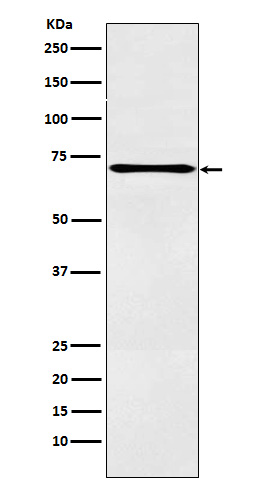Anti-LOX12 Rabbit Monoclonal Antibody
- SPECIFICATION
- CITATIONS
- PROTOCOLS
- BACKGROUND

Application
| WB |
|---|---|
| Primary Accession | P18054 |
| Host | Rabbit |
| Isotype | IgG |
| Reactivity | Rat, Human |
| Clonality | Monoclonal |
| Format | Liquid |
| Description | Anti-LOX12 Rabbit Monoclonal Antibody . Tested in WB application. This antibody reacts with Human, Rat. |
| Gene ID | 239 |
|---|---|
| Other Names | Polyunsaturated fatty acid lipoxygenase ALOX12, 1.13.11.-, Arachidonate (12S)-lipoxygenase, 12S-LOX, 12S-lipoxygenase, 1.13.11.31, Arachidonate (15S)-lipoxygenase, 1.13.11.33, Linoleate (13S)-lipoxygenase, Lipoxin synthase 12-LO, 3.3.2.-, Platelet-type lipoxygenase 12, ALOX12 (HGNC:429), 12LO, LOG12 |
| Calculated MW | 75 kDa |
| Application Details | WB 1:500-1:2000 |
| Contents | Rabbit IgG in phosphate buffered saline, pH 7.4, 150mM NaCl, 0.02% sodium azide and 50% glycerol, 0.4-0.5mg/ml BSA. |
| Clone Names | Clone: 24A29 |
| Immunogen | A synthesized peptide derived from human LOX12 |
| Purification | Affinity-chromatography |
| Storage | Store at -20°C for one year. For short term storage and frequent use, store at 4°C for up to one month. Avoid repeated freeze-thaw cycles. |
| Name | ALOX12 (HGNC:429) |
|---|---|
| Synonyms | 12LO, LOG12 |
| Function | Catalyzes the regio and stereo-specific incorporation of molecular oxygen into free and esterified polyunsaturated fatty acids generating lipid hydroperoxides that can be further reduced to the corresponding hydroxy species (PubMed:17493578, PubMed:18311922, PubMed:1851637, PubMed:32404334, PubMed:8319693, PubMed:8500694). Mainly converts arachidonate ((5Z,8Z,11Z,14Z)-eicosatetraenoate) to the specific bioactive lipid (12S)-hydroperoxyeicosatetraenoate/(12S)-HPETE (PubMed:17493578, PubMed:22984144, PubMed:24282679, PubMed:8319693, PubMed:8500694). Through the production of bioactive lipids like (12S)- HPETE it regulates different biological processes including platelet activation (PubMed:8319693, PubMed:8500694). It can also catalyze the epoxidation of double bonds of polyunsaturated fatty acids such as (14S)-hydroperoxy-docosahexaenoate/(14S)-HPDHA resulting in the formation of (13S,14S)-epoxy-DHA (PubMed:23504711). Furthermore, it may participate in the sequential oxidations of DHA ((4Z,7Z,10Z,13Z,16Z,19Z)-docosahexaenoate) to generate specialized pro- resolving mediators (SPMs) like resolvin D5 ((7S,17S)-diHPDHA) and (7S,14S)-diHPDHA, that actively down-regulate the immune response and have anti-aggregation properties with platelets (PubMed:32404334). An additional function involves a multistep process by which it transforms leukotriene A4/LTA4 into the bioactive lipids lipoxin A4/LXA4 and lipoxin B4/LXB4, both are vasoactive and LXA4 may regulate neutrophil function via occupancy of specific recognition sites (PubMed:8250832). Can also peroxidize linoleate ((9Z,12Z)-octadecadienoate) to (13S)- hydroperoxyoctadecadienoate/ (13S-HPODE) (By similarity). Due to its role in regulating both the expression of the vascular endothelial growth factor (VEGF, an angiogenic factor involved in the survival and metastasis of solid tumors) and the expression of integrin beta-1 (known to affect tumor cell migration and proliferation), it can be regarded as protumorigenic (PubMed:16638750, PubMed:22237009, PubMed:9751607). Important for cell survival, as it may play a role not only in proliferation but also in the prevention of apoptosis in vascular smooth muscle cells (PubMed:23578768). |
| Cellular Location | Cytoplasm, cytosol. Membrane. Note=Membrane association is stimulated by EGF |
| Tissue Location | Expressed in vascular smooth muscle cells. |

Thousands of laboratories across the world have published research that depended on the performance of antibodies from Abcepta to advance their research. Check out links to articles that cite our products in major peer-reviewed journals, organized by research category.
info@abcepta.com, and receive a free "I Love Antibodies" mug.
Provided below are standard protocols that you may find useful for product applications.
If you have used an Abcepta product and would like to share how it has performed, please click on the "Submit Review" button and provide the requested information. Our staff will examine and post your review and contact you if needed.
If you have any additional inquiries please email technical services at tech@abcepta.com.













 Foundational characteristics of cancer include proliferation, angiogenesis, migration, evasion of apoptosis, and cellular immortality. Find key markers for these cellular processes and antibodies to detect them.
Foundational characteristics of cancer include proliferation, angiogenesis, migration, evasion of apoptosis, and cellular immortality. Find key markers for these cellular processes and antibodies to detect them. The SUMOplot™ Analysis Program predicts and scores sumoylation sites in your protein. SUMOylation is a post-translational modification involved in various cellular processes, such as nuclear-cytosolic transport, transcriptional regulation, apoptosis, protein stability, response to stress, and progression through the cell cycle.
The SUMOplot™ Analysis Program predicts and scores sumoylation sites in your protein. SUMOylation is a post-translational modification involved in various cellular processes, such as nuclear-cytosolic transport, transcriptional regulation, apoptosis, protein stability, response to stress, and progression through the cell cycle. The Autophagy Receptor Motif Plotter predicts and scores autophagy receptor binding sites in your protein. Identifying proteins connected to this pathway is critical to understanding the role of autophagy in physiological as well as pathological processes such as development, differentiation, neurodegenerative diseases, stress, infection, and cancer.
The Autophagy Receptor Motif Plotter predicts and scores autophagy receptor binding sites in your protein. Identifying proteins connected to this pathway is critical to understanding the role of autophagy in physiological as well as pathological processes such as development, differentiation, neurodegenerative diseases, stress, infection, and cancer.


